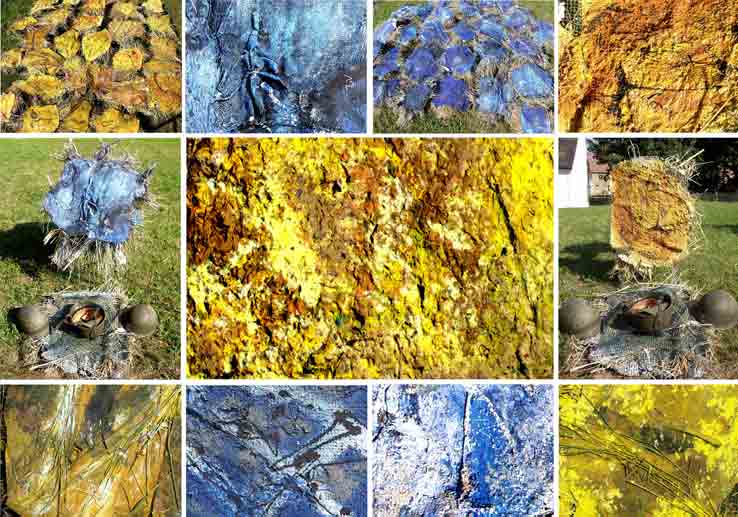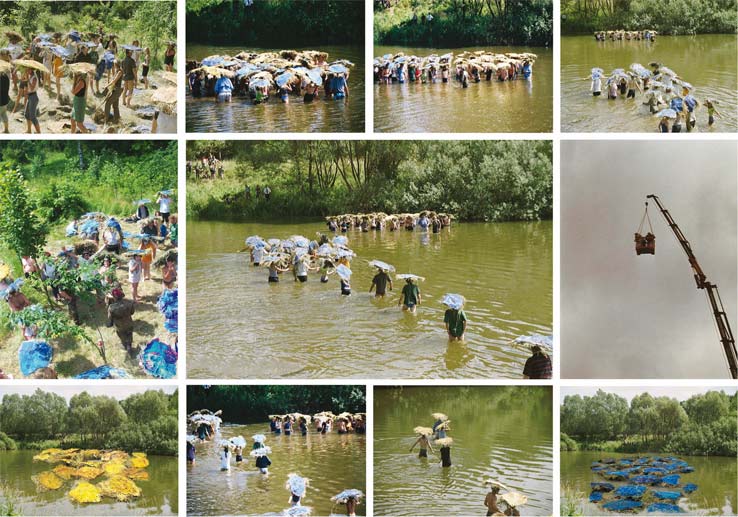
 In the early summer of 2002, the German Bundeswehr donated 200 helmets of war to the Batuz Stiftung Sachsen in Altzella, Saxony for the project “no más fronteras Piensk-Rothenburg”. These same helmets play an essential role not only in the execution of the projects aims but also in its symbolic representation of the general message. The utilization here of an equipment of war together with a work of art stands as a stark demonstration for peace and the nature of this project; no más fronteras.
In the early summer of 2002, the German Bundeswehr donated 200 helmets of war to the Batuz Stiftung Sachsen in Altzella, Saxony for the project “no más fronteras Piensk-Rothenburg”. These same helmets play an essential role not only in the execution of the projects aims but also in its symbolic representation of the general message. The utilization here of an equipment of war together with a work of art stands as a stark demonstration for peace and the nature of this project; no más fronteras.
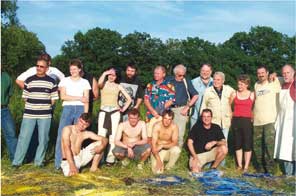 Resulting from a long standing practice to raise issues from a local to global dimension, Batuz had already invited the international community to join him for his project and his workshops in Altzella. Participants and long standing assistants already arrived to Altzella from around the world and would be the ones who helped in the elementary construction of the work that would be realized on the Neiße River.
Resulting from a long standing practice to raise issues from a local to global dimension, Batuz had already invited the international community to join him for his project and his workshops in Altzella. Participants and long standing assistants already arrived to Altzella from around the world and would be the ones who helped in the elementary construction of the work that would be realized on the Neiße River.
 Marek Szymanski, Zbygniew Lagocki, Ola Grela, Monika Mroczkowska from Poland, Abel Konya from Hungary, Edgardo Flores, Daniel Escardo, Rito Rodriguez, Roberto Piriz, Paula Galindez from Uruguay, Barbara Gutowski, Marlies Braksiek, Steffen Lange, Bernd Kaufmann, Waldemar Schneider, Ulrich Prüger, Gudrun Neumann, Aleksander Nowakowski from Altzella, Larry Chappelear from Maryland, Micheal Keating from California, Ewa Okolewicz from Warsaw, Gladys Zagert from Argentina from Potsdam, and Nagi Adip from Egypt, each had a hand in creating these helmet paintings which would then be joined together in order to form the desired project on the Neiße.
Marek Szymanski, Zbygniew Lagocki, Ola Grela, Monika Mroczkowska from Poland, Abel Konya from Hungary, Edgardo Flores, Daniel Escardo, Rito Rodriguez, Roberto Piriz, Paula Galindez from Uruguay, Barbara Gutowski, Marlies Braksiek, Steffen Lange, Bernd Kaufmann, Waldemar Schneider, Ulrich Prüger, Gudrun Neumann, Aleksander Nowakowski from Altzella, Larry Chappelear from Maryland, Micheal Keating from California, Ewa Okolewicz from Warsaw, Gladys Zagert from Argentina from Potsdam, and Nagi Adip from Egypt, each had a hand in creating these helmet paintings which would then be joined together in order to form the desired project on the Neiße.
 General von Kirchbach took the initiative of writing to the commanders of the 13th and 14th armored infantry divisions, Major General Wolf-Dieter Löser and Major General Wolfgang Korte, to inform artistically-interested and creative officers and non-commissioned officers about this project, to give them release time thereby making it possible for them to participate. This group of the German Army has rendered great services in preparing and carrying out this project. Oberstleutnant Hans-Jochen Diederich, Oberstleutnant i.R. Helmut Scheuck, Oberfeldwebel Andreas Bernhard, Stabs-Unteroffizier Simone Moch, Hauptgefreiter Enrico Zienke, Unteroffizier Steve Koch and Obergefreiter Dan Schmidt all contributed and without their active support the project could not have been as successful as it was.
General von Kirchbach took the initiative of writing to the commanders of the 13th and 14th armored infantry divisions, Major General Wolf-Dieter Löser and Major General Wolfgang Korte, to inform artistically-interested and creative officers and non-commissioned officers about this project, to give them release time thereby making it possible for them to participate. This group of the German Army has rendered great services in preparing and carrying out this project. Oberstleutnant Hans-Jochen Diederich, Oberstleutnant i.R. Helmut Scheuck, Oberfeldwebel Andreas Bernhard, Stabs-Unteroffizier Simone Moch, Hauptgefreiter Enrico Zienke, Unteroffizier Steve Koch and Obergefreiter Dan Schmidt all contributed and without their active support the project could not have been as successful as it was.
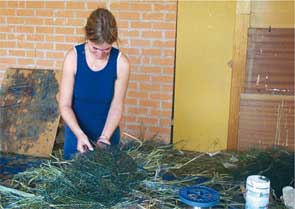 Through the help of all the participants, Batuz experimented various methods to actually create a surface that would be possible to eventually be carried by the helmet. This was no easy feat and took several trials before a solution was found.
Through the help of all the participants, Batuz experimented various methods to actually create a surface that would be possible to eventually be carried by the helmet. This was no easy feat and took several trials before a solution was found.
Various layers of material needed to be combined in order to create the surface necessary and in such a way that it could be bound to the individual helmets. Paper pulp, grass, newspaper, glue, and a thin wire mesh were the principal materials used, stemming from some prior methods applied by Batuz in other works of art. (see Works in Paper)
 Cutting randomly sized patterns from rolls of thin wire mesh, the participants began to combine layers of the remaining materials until a stable, flat but textured surface emerged. This surface, strongly supported through the combination of glue, grass, and newspaper then allowed for the final layer of paper pulp to settle and create the painterly surface. Once the desired surface was constructed, the various sheets were placed on racks in the open air and left to dry completely.
Cutting randomly sized patterns from rolls of thin wire mesh, the participants began to combine layers of the remaining materials until a stable, flat but textured surface emerged. This surface, strongly supported through the combination of glue, grass, and newspaper then allowed for the final layer of paper pulp to settle and create the painterly surface. Once the desired surface was constructed, the various sheets were placed on racks in the open air and left to dry completely.
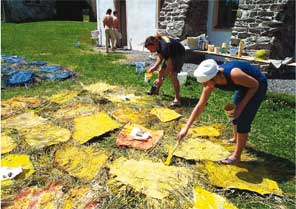 The various participants then divided the few hundred sheets created and each had a hand in painting them all. Professionals and amateurs alike painted side by side. Dozens of people spread out throughout the grounds, each painting in his own form. In this way, no two were created alike. Even the two colors, specifically selected to symbolically represent not only Poland’s entrance into the European Union, but also of the latter’s expansion to the east and its similar aim of overcoming border differences, had naturally different tones throughout the various works created. The result was a cacophony of completely different designs and yet when together seemed to come together.
The various participants then divided the few hundred sheets created and each had a hand in painting them all. Professionals and amateurs alike painted side by side. Dozens of people spread out throughout the grounds, each painting in his own form. In this way, no two were created alike. Even the two colors, specifically selected to symbolically represent not only Poland’s entrance into the European Union, but also of the latter’s expansion to the east and its similar aim of overcoming border differences, had naturally different tones throughout the various works created. The result was a cacophony of completely different designs and yet when together seemed to come together.
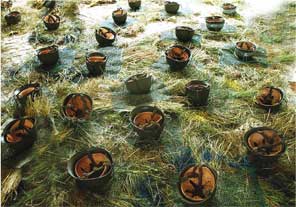 The final challenge then remained to mount the surfaces upon the helmets. Drilling almost an impossibility, the participants began to each bind the surfaces to the interiors of the helmets using thin wire. Once again, a different hand reached a helmet that was first worn by some soldier, which had been delivered by another, where grass cut by someone, mixed with paper and glue by another, topped with paper pulp by another, was then painted by another, and eventually worn by another, has been worked upon by yet another individual. The helmets were then ready for the Neiße.
The final challenge then remained to mount the surfaces upon the helmets. Drilling almost an impossibility, the participants began to each bind the surfaces to the interiors of the helmets using thin wire. Once again, a different hand reached a helmet that was first worn by some soldier, which had been delivered by another, where grass cut by someone, mixed with paper and glue by another, topped with paper pulp by another, was then painted by another, and eventually worn by another, has been worked upon by yet another individual. The helmets were then ready for the Neiße.
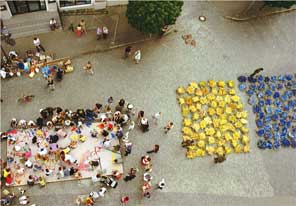 In the main square of the town of Rothenburg, with the international participants from the foundation, the help of the German Bundeswehr, people from both sides of the border, directly or from afar, came together for the project. The entire square was filled with people and the mass simply grew as passersby gave up what they were doing and lent a hand. A crane with a 38 meter extension was also assembled so that the activities in the square could be documented on film.
In the main square of the town of Rothenburg, with the international participants from the foundation, the help of the German Bundeswehr, people from both sides of the border, directly or from afar, came together for the project. The entire square was filled with people and the mass simply grew as passersby gave up what they were doing and lent a hand. A crane with a 38 meter extension was also assembled so that the activities in the square could be documented on film.
 While certain assistants and members of the Bundeswehr began to number and arrange the helmets in the square, others unrolled an enormous carpet, 12’ x 27’, that had been previously outlined with the map of the surrounding area. Distributing paints and brushes to the many that gathered, all were asked to contribute in the painting of the two sides of the border. Generals and children, businessmen in suits and women in traditional dress, professionals and students, even handicapped from wheelchairs who were given brushes with extensions, all participated. The result was a most mysterious work of art, springing from the outline of a map colored by an uncountable many and which turned into a work from Batuz. This collective work was once again another success in the application of communication through art.
While certain assistants and members of the Bundeswehr began to number and arrange the helmets in the square, others unrolled an enormous carpet, 12’ x 27’, that had been previously outlined with the map of the surrounding area. Distributing paints and brushes to the many that gathered, all were asked to contribute in the painting of the two sides of the border. Generals and children, businessmen in suits and women in traditional dress, professionals and students, even handicapped from wheelchairs who were given brushes with extensions, all participated. The result was a most mysterious work of art, springing from the outline of a map colored by an uncountable many and which turned into a work from Batuz. This collective work was once again another success in the application of communication through art.
 The helmets then having been positioned and arranged, were distributed to the many who eagerly offered to further participate. Each was designated a certain number, which corresponded to a certain helmet and also a certain position. They were then strapped onto the participant, usually with some assistance, after which all then made there way down to the neighboring river. The procession was very long and continued to grow in size as interested bystanders continued to drop what they were doing and joined in.
The helmets then having been positioned and arranged, were distributed to the many who eagerly offered to further participate. Each was designated a certain number, which corresponded to a certain helmet and also a certain position. They were then strapped onto the participant, usually with some assistance, after which all then made there way down to the neighboring river. The procession was very long and continued to grow in size as interested bystanders continued to drop what they were doing and joined in.
 Once the procession reached the river, they were met by others from the other side, from the Polish side, who immediately waded through the water and joined the rest of the group. A few remaining helmets were then passed off to the late comers.
Once the procession reached the river, they were met by others from the other side, from the Polish side, who immediately waded through the water and joined the rest of the group. A few remaining helmets were then passed off to the late comers.
With this group then divided according to their numbers, the leading assistants, from the foundation and the German Bundeswehr, began to direct the crowd under the instruction from Batuz. This was done through wireless communication as Batuz was raised 38 meters above the river with one assistant and a cameraman who was documenting the event.
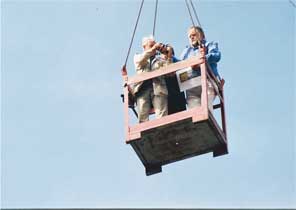 Upon the command from Batuz, the called sections began to wade into the middle of the river on the upper Neiße, the border between Poland and Germany. One section after another until the image preconceived by Batuz and arranged in the square became apparent from above. With a few corrections, the incredible many standing there in the middle of the border, created in their collection the large work of art that stood as a symbol to Batuz’ work and the common desire shared by all that participated. To reinforce this common desire, Batuz then gave the command for the two sides to mix, thus breaking through the border that had divided people for so long and thus visualizing the hopefully united Europe, not solely in an economic sense but truly through its people.
Upon the command from Batuz, the called sections began to wade into the middle of the river on the upper Neiße, the border between Poland and Germany. One section after another until the image preconceived by Batuz and arranged in the square became apparent from above. With a few corrections, the incredible many standing there in the middle of the border, created in their collection the large work of art that stood as a symbol to Batuz’ work and the common desire shared by all that participated. To reinforce this common desire, Batuz then gave the command for the two sides to mix, thus breaking through the border that had divided people for so long and thus visualizing the hopefully united Europe, not solely in an economic sense but truly through its people.
The aerial documentation was an essential part in the physical realization because it created a permanent work of art by making the “Interrelation of Forms” visible. Please view our video in order to see the final work of art.
